Thanks to a chance encounter in graduate school, Diane Ragone, Ph.D., director of the Breadfruit Institute at NTBG, dedicated her life to documenting and preserving a nutritious, starchy, and storied fruit of the Pacific. Breadfruit, or ulu as it is known in Hawaii, may be the key to preventing the loss of traditional and culturally significant food crops and stabilizing food and economic security in the tropics. NTBG and the Breadfruit Institute are stemming the tide of plant loss and food insecurity with your help. When you donate to the National Tropical Botanical Garden, you’re a part of this critical work that is keeping our plants and our planet healthy.
In 1981, Diane Ragone, a horticulturist interested in tropical fruit, moved to the Hawaiian Island of Oahu for graduate studies at the University of Hawaii in the Horticulture Department. After a chance encounter and single taste of the nutritious, starchy, and storied fruit, commonly known as breadfruit or ulu in Hawaii, Diane decided to make it the subject of a term paper. “The history of breadfruit was so interesting to me because of how widely it was grown throughout the Pacific Islands and how important it was culturally and as a food staple for so many Pacific Islanders for centuries,” she said.
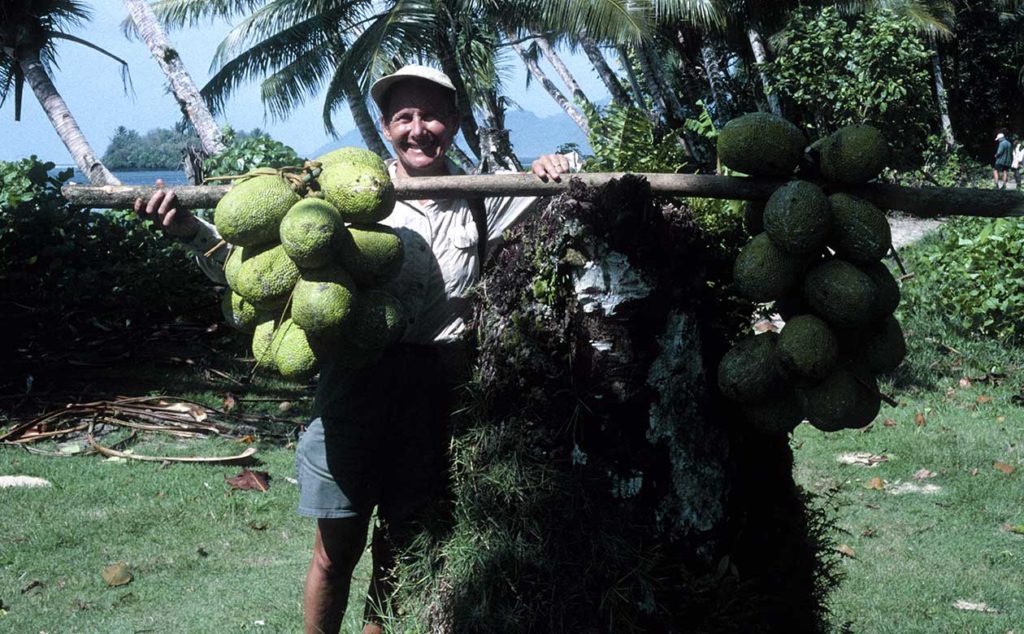
“The history of breadfruit was so interesting to me because of how widely it was grown throughout the Pacific Islands and how important it was culturally and as a food staple for so many Pacific Islanders for centuries.”
Dr. Diane Ragone, Director, the Breadfruit Institute
Breadfruit originated in New Guinea and the Indo-Malay region and was spread throughout the vast Pacific by voyaging islanders. Europeans discovered breadfruit in the late 1500s and were delighted by a tree that produced prolific, starchy fruits that resembled freshly baked bread in texture and aroma when roasted in a fire.
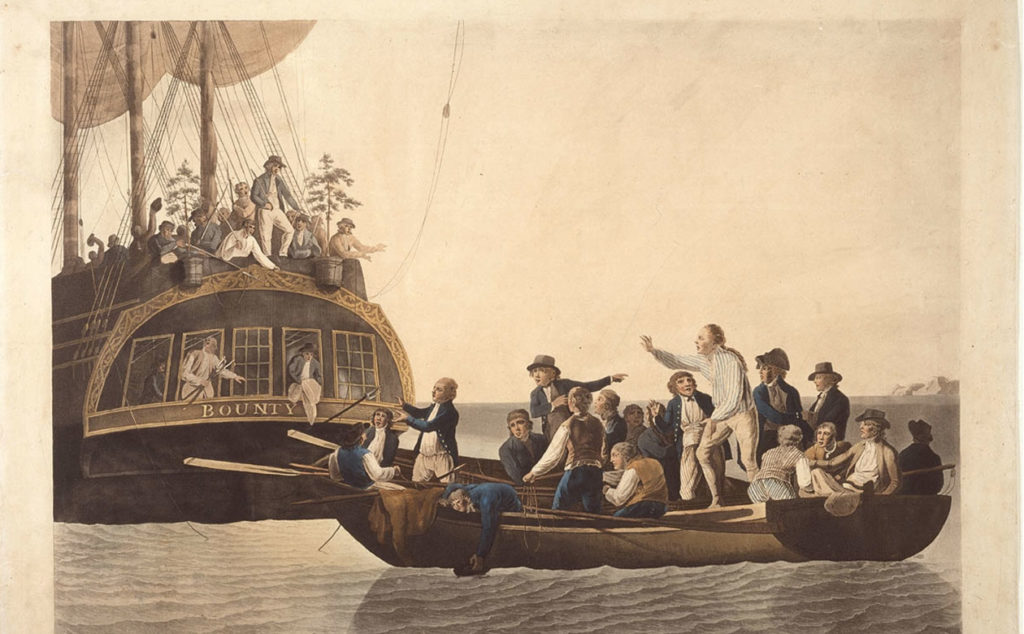
Sir Joseph Banks, who sailed on HMS Endeavour with Captain Cook to Tahiti in 1769, recognized the potential of breadfruit as a food crop for other tropical areas. He proposed to King George III that a special expedition be commissioned to transport breadfruit plants from Tahiti to the Caribbean. This set the stage for one of the grandest sailing adventures of all time – The ill-fated voyage of HMS Bounty under the command of Captain William Bligh.
What is little known is that Captain Bligh returned to Tahiti on the aptly named HMS Providence to continue the breadfruit voyage. Several Tahitian varieties, and an unknown variety from Timor, were successfully introduced to the Caribbean in 1793. While many accounts dismiss this epic plant introduction as a failure because the islands’ population did not initially accept this new crop as a food, subsequent centuries have proved the value of breadfruit to the Caribbean and other tropical areas.
A renewed interest in breadfruit emerged in the 1920s and 1940s after World War II when botanists and scientists realized that many traditional food crops and cultivation practices were at risk of disappearing from the Pacific Islands. “Plant introductions were of particular interest to me, so I approached my research from the angle of collection, conservation, and documentation of breadfruit diversity,” said Dr. Ragone. “It was fascinating for me to learn that there were places in the Pacific that had documented 50, 60, even a hundred varieties of breadfruit,” she continued.
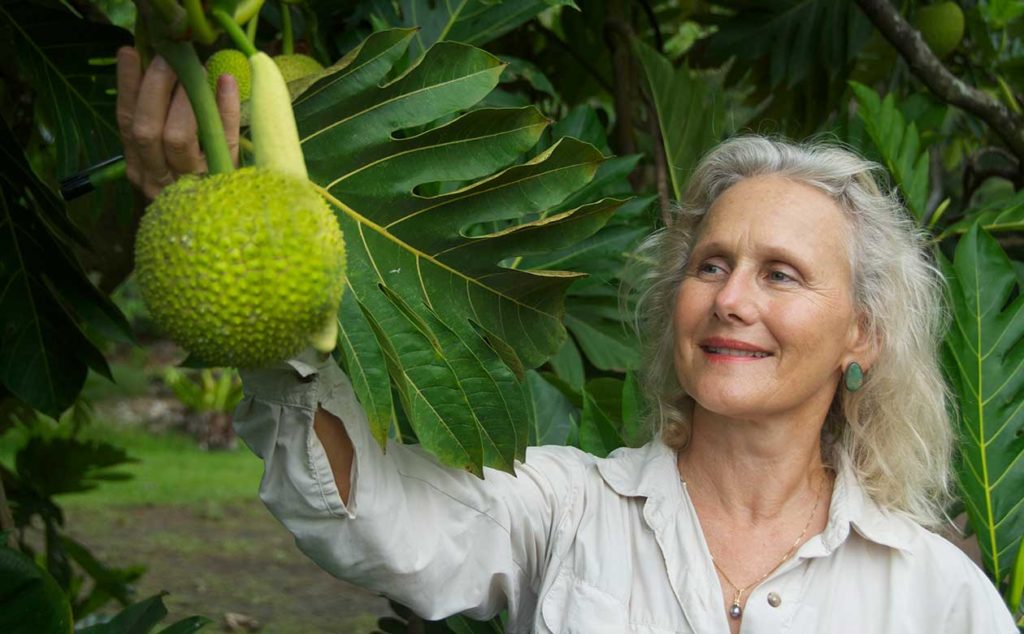
In 2003 Diane established the Breadfruit Institute to promote the conservation, study, and use of breadfruit for food and reforestation and is a global leader in efforts to conserve and use breadfruit diversity to support regenerative agriculture, food security, and economic development in the tropics.
Compared to an annual field crop, breadfruit trees are easy to plant and can produce anywhere from 300 to 1,200 pounds of starchy, nutritious food every year for decades. Breadfruit grows in tropical regions worldwide, which have some of the highest instances of food insecurity and poverty anywhere. 85% of the places around the world where hunger and poverty are most acute, breadfruit can grow. This makes breadfruit an incredible resource for bolstering food security and creating economic opportunity for the farmers and families where it is needed most.
“Even in Hawaii, it’s hard to be a farmer and make enough money to pay your bills.”
Noel Dickinson, NTBG Research Technician
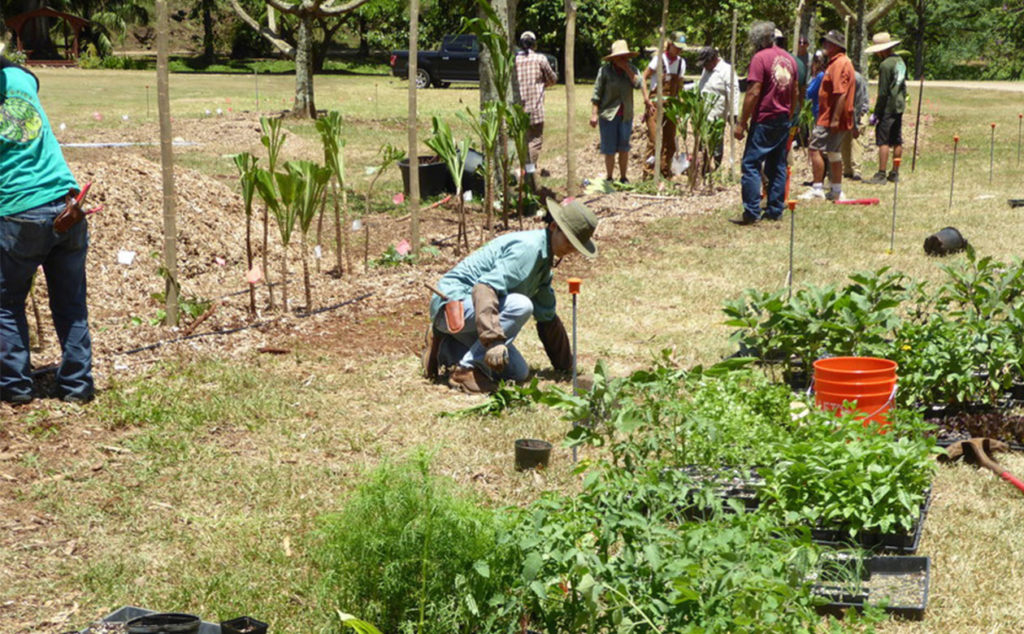
“Even in Hawaii, it’s hard to be a farmer and make enough money to pay your bills,” said Noel Dickinson, Research Technician at National Tropical Botanical Garden. “What we are trying to demonstrate with the Regenerative Organic Breadfruit Agroforest in McBryde Garden is a way for farmers and individuals in Hawaii and tropical regions around the world to diversify and utilize all of their land with ulu as the backbone of their system,” she continued.
Agroforestry is a farming method that integrates trees, shrubs, and other plants with crops or animals in ways that provide economic, environmental, and social benefits. In 2017, NTBG’s Breadfruit Institute established a two-acre Regenerative Organic Breadfruit Agroforestry demonstration in McBryde Garden with funding from the Hawaii Department of Agriculture and Patagonia Provisions. The demonstration garden contains more than 100 plant species and varieties, which are monitored weekly for production. In 2020, the ROBA demonstration has produced more than 6,000 pounds of fresh food, approximately 20,000 meals, which has been donated to staff, volunteers, and organizations mitigating food insecurity on Kauai during the pandemic.
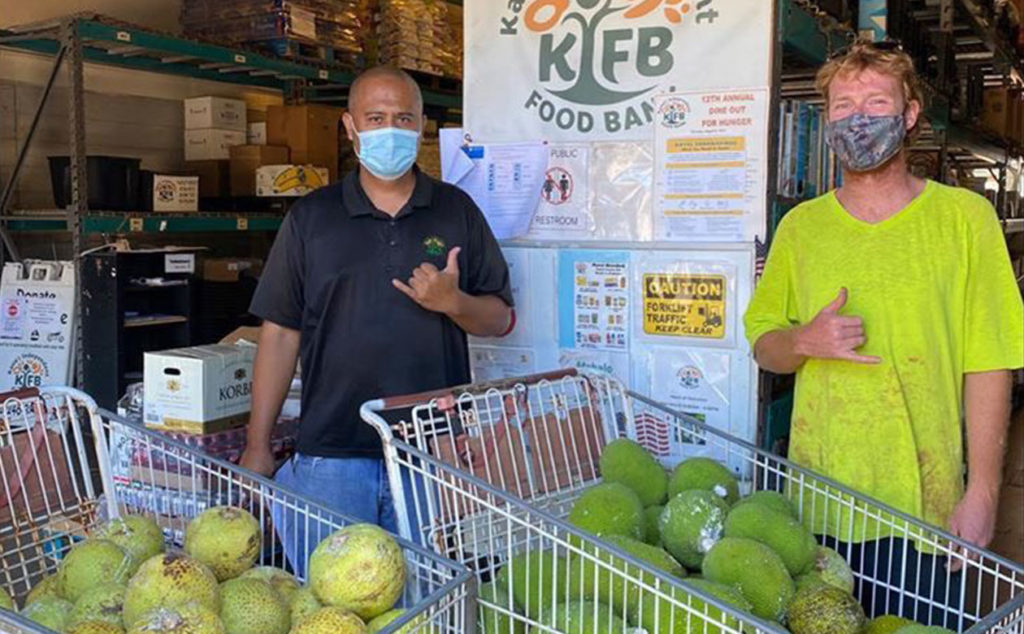
“One pound of breadfruit feeds 2-4 people,” said Kelvin Moniz, Executive Director of the Kauai Independent Food Bank. “We calculate it by assuming people are putting 2-4 oz. of starch on their plate during a meal. With the breadfruit from NTBG and some other local sources, we handed out one ulu per car and were able to give away more than 200 during one Friday afternoon distribution,” he concluded.
“At first, people were really surprised that we had ulu at the Food Bank, and gradually they have started to ask for it more and more. It is great to see the desire for ulu increase and all of the different ways people are preparing and sharing it with their families.”
Kelvin Moniz, Kauai Independent Food Bank
Nutritionally breadfruit compares favorably with other starchy staple crops commonly eaten in the tropics, such as taro, plantain, cassava, sweet potato, and rice. It is a good source of dietary fiber, iron, potassium, calcium, phosphorus, and magnesium with small amounts of thiamin, riboflavin, and niacin. Breadfruit is gluten-free and a complete protein, providing all of the essential amino acids necessary to human health. “At first, people were really surprised that we had ulu at the Food Bank, and gradually they have started to ask for it more and more,” said Kevin. “It is great to see the desire for ulu increase and all different ways people are preparing and sharing it with their families,” he finished.
Breadfruit has long been a staple crop and a critical component of traditional agroforestry systems throughout Oceania. There is so much we can learn and apply today from how it has been cultivated throughout history. “Breadfruit agroforestry typifies regenerative agriculture as indigenous people of the tropics have practiced it for centuries,” said Dr. Ragone. “They had no outside inputs, only organic resources provided by the land and sea, so every part of the agroforestry system interacted and worked together to rebuild and add nutrients back into the soil,” she continued. Unlike other starchy food crops, breadfruit does not require annual soil tilling and provides more significant carbon sequestration benefits for the environment, which helps mitigate climate change.

“What is most dear to my heart is local abundance. We need to diversify agriculture in tropical regions, and breadfruit is an important staple crop that can do that while providing local and community self-sufficiency and food security.”
Dr. Diane Ragone, Director, the Breadfruit Institute
Over the last decade, more than 100,000 breadfruit trees have been planted in Hawaii and around the globe thanks to the efforts of The Breadfruit Institute and partners in its Global Hunger Initiative such as the Hawaii Homegrown Food Network, Trees That Feed Foundation, Cultivaris, and many more. Now that individuals, families, and farms have more access to breadfruit, so do entrepreneurs who can develop novel food and products, leading to economic growth. “What is most dear to my heart is local abundance,” said Dr. Ragone. “We need to diversify agriculture in tropical regions, and breadfruit is an important staple crop that can do that while providing local and community self-sufficiency and food security.”
From its origins in Oceania to historical expeditions, botanical introductions, and conservation efforts, breadfruit has been on an incredible journey to the modern world. Thanks to generous supporters, partners, and volunteers like you, NTBG and the Breadfruit Institute will continue to study, fuel economic growth, and drive agricultural innovation with breadfruit.
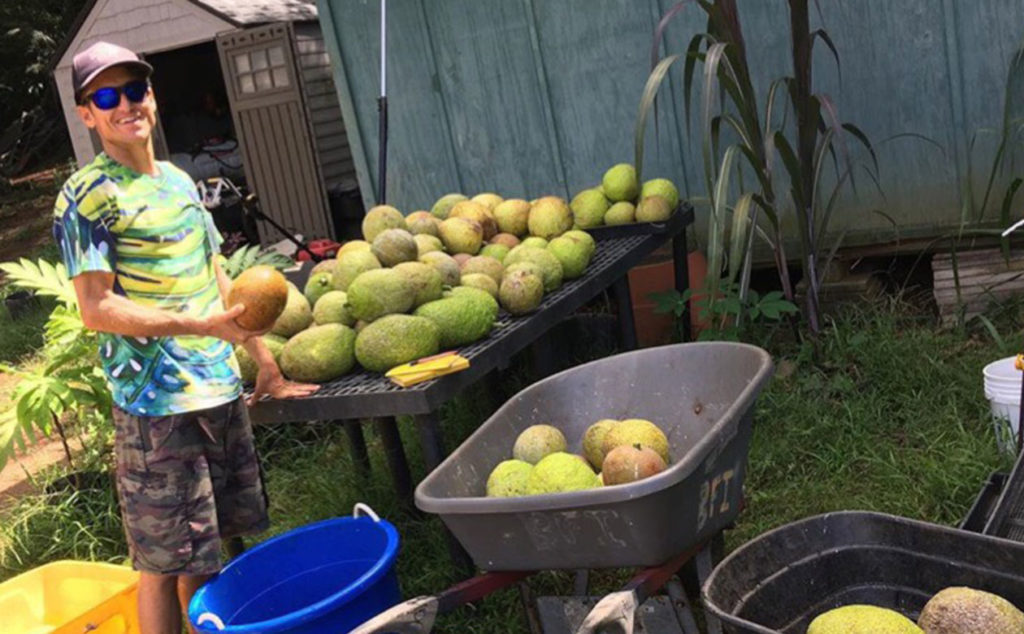
Want to get involved? Donate to the Healthy Plants. Healthy Planet campaign to support NTBG science, research, and conservation efforts today and learn more about opportunities to visit and volunteer. “My husband and I are avid gardeners and learned about the wonders of breadfruit during a visit to McBryde Garden in 2015,” said Anne Cyr, NTBG volunteer. “A later trip to St. Kitts and the West Indies broadened our understanding of breadfruit’s importance, and we signed up to volunteer at the Breadfruit Institute during our next visit to Kauai. We planted taro, harvested, and weighed lots of breadfruit and learned so much! We can’t wait to get back and work beneath the beautiful and bountiful trees again,” she exclaimed.
Give now to support food security and check out these resources, entrepreneurs, and partners for more information on breadfruit.
An Interview with the Mother of the Breadfruit Movement, Hawaii Public Radio
Breadfruit Institute
Breadfruit Agroforestry Guide
Patagonia Provisions Agroforestry Partners
Global Hunger Initiative
Hawaii Homegrown Food Network
Maui Breadfruit Company